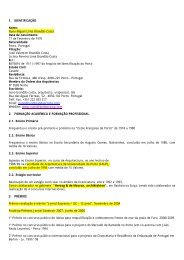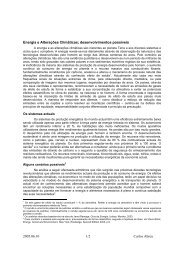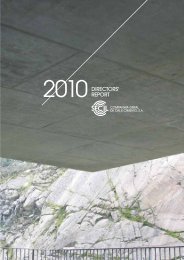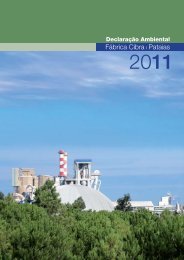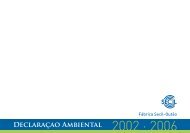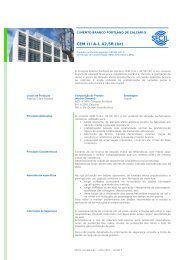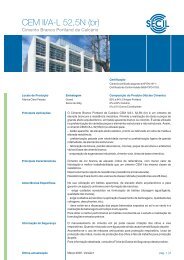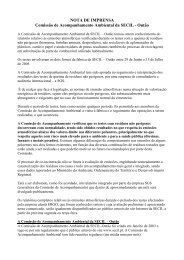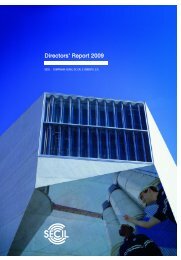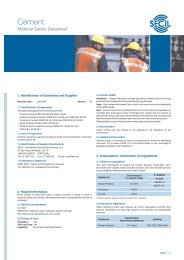5. - Secil
5. - Secil
5. - Secil
Create successful ePaper yourself
Turn your PDF publications into a flip-book with our unique Google optimized e-Paper software.
NOTES ON CONSOLIDATED<br />
FINANCIAL STATEMENTS<br />
FOR THE FINANCIAL YEAR ENDED<br />
31 DECEMBER 2008.<br />
(Amounts presented in Euro unless otherwise<br />
stated)<br />
SECIL GROUP (“Group”) comprises <strong>Secil</strong> –<br />
Companhia Geral de Cal e Cimento, S.A.<br />
(“<strong>Secil</strong>”) and its subsidiaries. <strong>Secil</strong> was incorporated<br />
on 27 June 1918, and has as its<br />
main object the production and trade of<br />
cement produced in its Outão plant, Setúbal,<br />
and has several depots throughout Portugal.<br />
Head Office:<br />
Outão, Setubal<br />
Share Capital:<br />
Euros 264 600 000<br />
N.I.P.C.:<br />
500 243 599<br />
<strong>Secil</strong> is the main company of a Group operating<br />
in Portugal, Tunisia, Spain, Angola,<br />
France, Lebanon and Cape Verde. Its core<br />
business covers cement production,<br />
through its subsidiaries, in its plants in<br />
Outão, Maceira, Pataias (Portugal), Gabés<br />
(Tunisia), Lobito (Angola) and Sibline (Lebanon),<br />
premixed concrete production and<br />
trade, aggregates, quarrying, through its<br />
Sub-Holding company <strong>Secil</strong> Betões e<br />
Inertes, SGPS, S.A., incorporated on 29<br />
March 2000.<br />
These consolidated financial statements<br />
were approved by the Board of Directors<br />
on 5 March, 2009.<br />
The board members, who sign this<br />
report, declare that, according to their knowledge,<br />
the information herein contained<br />
was prepared in accordance with applicable<br />
Accounting Standards, giving a true view<br />
of assets and liabilities, financial position<br />
and results of companies included in the<br />
Group consolidated financial statements.<br />
1. SUMMARY OF MAIN ACCOUNTING<br />
POLICIES<br />
The main accounting policies applied in the<br />
preparation of the consolidated financial<br />
statements are set out below.<br />
<strong>5.</strong> Notes of the Consolidated<br />
Financial Statements<br />
1.1. BASIS OF PRESENTATION<br />
In 2007, the board of directors decided to<br />
reformulate the presentation of the Group’s<br />
financial information, anticipating the gradual<br />
implementation of the New Portuguese<br />
Accounting System (“SNC” Sistema de<br />
Normalização Contabilística) aimed at the<br />
following: (i) Compliance with legal and<br />
accounting rules and standards of Portugal’s<br />
official plan of accounts; (ii) Presentation of<br />
accurate financial information aligned with<br />
internationally accepted accounting standards<br />
and disclosure requirements, as required<br />
by the “SNC”.<br />
1.2. BASIS OF PREPARATION<br />
The Group’s consolidated financial statements<br />
were prepared in accordance with<br />
generally accepted accounting principles<br />
in Portugal, adapted with the application<br />
of certain International Financial Reporting<br />
Standards, namely, goodwill depreciation,<br />
actuarial gains and losses on defined<br />
benefit plans and derivative financial instruments,<br />
laid out in IFRS 3, IAS 19 and<br />
IAS 39, respectively.<br />
In 2005, with effect from January 1,<br />
2004, the Group ceased the periodic amortisation<br />
of goodwill. Only impairment losses<br />
on goodwill are registered in the<br />
income statement.<br />
In 2006 the Group changed its accounting<br />
policy related to the recognition of<br />
actuarial gains and losses, applying IAS<br />
19, published by the IASB on December<br />
16, 2004 and approved by Regulation<br />
1910/2005 of the European Commission<br />
on November 8, 2005, which introduced<br />
an option to recognise actuarial gains and<br />
losses of defined benefit plans directly<br />
through equity.<br />
These consolidated financial statements<br />
were prepared on a going concern<br />
basis, from accounting records of companies<br />
included in the consolidation scope<br />
herein (Note 43) and based on historical<br />
cost, except for CO 2 emission allowances<br />
and financial instruments which are<br />
measured and reported at fair value (Notes<br />
16 and 32).<br />
The preparation of the financial statements<br />
requires the use of estimates and relevant<br />
judgements when implementing the Group’s<br />
accounting policies. Significant estimates<br />
and assumptions involving a higher degree<br />
of judgment or complexity are disclosed in<br />
Note 3.<br />
1.3. BASIS OF CONSOLIDATION<br />
1.3.1. SUBSIDIARIES<br />
Subsidiaries are all entities over which the<br />
Group has the power to determine their<br />
financial and operating policies, generally<br />
considered to exist where the Group holds,<br />
directly or indirectly more than 50% of voting<br />
rights. The existence and the effect of potential<br />
voting rights, whether exercisable or<br />
convertible are considered when the Group<br />
assesses its control. Subsidiaries are fully<br />
consolidated from the date on which control<br />
is transferred to the Group and are excluded<br />
from consolidation from the date on<br />
which control ceases.<br />
The shareholders’ equity and net profit of<br />
these companies that are attributable to<br />
third parties are presented separately in the<br />
consolidated balance sheet and consolidated<br />
income statement under the caption<br />
“Minority interests”. Companies included in<br />
the consolidated financial statements are<br />
disclosed in Note 43.<br />
The acquisition of subsidiaries is accounted<br />
for on the purchase method. The cost of<br />
an acquisition is measured by the fair value<br />
of the identifiable assets, equity instruments<br />
issued and liabilities incurred or assumed at<br />
the date of the transaction, plus costs<br />
directly attributable to the acquisition.<br />
Identifiable assets and liabilities and contingent<br />
liabilities acquired in a business combination<br />
are measured initially at their fair<br />
value on acquisition date, irrespective of the<br />
existence of any minority interest. The<br />
excess of the acquisition cost over the fair<br />
value of the Group’s share of the identifiable<br />
net assets acquired is recorded as<br />
Goodwill, as shown in Note 1<strong>5.</strong><br />
When the Group acquires the control of<br />
an associate, and commences with the



